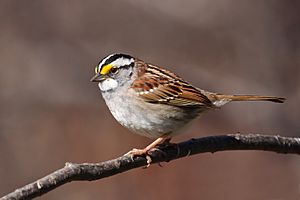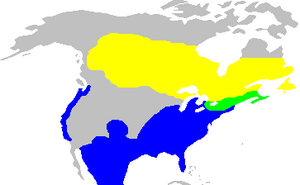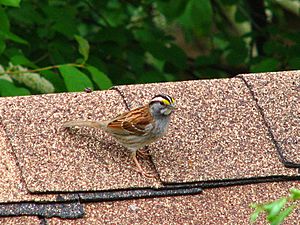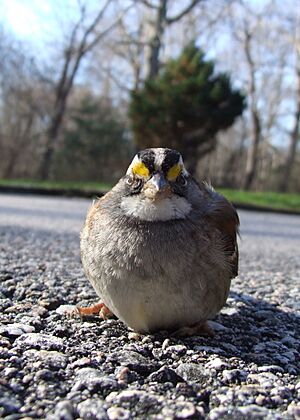White-throated sparrow facts for kids
The white-throated sparrow (Zonotrichia albicollis) is a small bird from the New World sparrow family. These birds are known for their clear songs and distinct markings. They are common in North America.
Quick facts for kids White-throated sparrow |
|
|---|---|
 |
|
| White-throated sparrow in Cap Tourmente National Wildlife Area, Quebec, Canada | |
| Conservation status | |
| Scientific classification | |
| Genus: |
Zonotrichia
|
| Species: |
albicollis
|
 |
|
| Range of Z. albicollis Breeding range Year-round range Wintering range | |
Contents
What's in a Name?
The name Zonotrichia comes from Ancient Greek words meaning "band" and "hair." The second part of its scientific name, albicollis, comes from Latin words meaning "white" and "neck." This perfectly describes the bird's white throat!
How to Spot a White-Throated Sparrow
The white-throated sparrow is a passerine bird. It measures about 15 to 19 centimeters (6 to 7.5 inches) long. Its wingspan is around 23 cm (9 inches). These birds usually weigh between 22 and 32 grams (0.8 to 1.1 ounces).
They look a bit like the white-crowned sparrow. But white-throated sparrows have clear white throat markings. They also have yellow patches near their eyes, called lores.
Different Looks: White-Striped and Tan-Striped

Adult white-throated sparrows have two main looks. These are called the tan-striped and white-striped forms.
- White-striped form: These birds have a black crown (top of the head) with a white stripe in the middle. They also have white stripes above their eyes. Their cheeks are gray, with a black line above their eyes.
- Tan-striped form: These birds have a dark brown crown with a tan stripe in the middle. Their stripes above the eyes are also tan. Their cheeks are gray or light brown, with a brown line above their eyes.
Both types have dark eyes, a white throat, yellow lores, and a gray beak. Some birds might have dark stripes on the sides of their throat.
The chest has gray or tan streaks. These streaks continue down the sides. But the belly is usually light gray. Their wings are reddish-brown with two clear white bars. Male and female sparrows look very similar.
Interestingly, white-striped birds are more aggressive. This is especially true during the breeding season. This behavior is due to a chemical in their bodies.
Sparrow Behavior
Life Cycle and Reproduction
White-throated sparrows breed in central Canada and New England. They build their nests on the ground under bushes. Sometimes they nest low in trees. They prefer forests with both deciduous and mixed trees. Females lay three to five eggs. The eggs are blue or green-white with brown marks.
The tan and white forms of these sparrows have different ways of raising young.
- Tan males focus on caring for their young. They also guard their mates.
- White males try to find more mates. They sing loudly to attract females. They also try to enter other birds' territories.
Female sparrows also show differences:
- Tan females focus on parental care.
- White females may try to find extra mates. They might also lay their eggs in another bird's nest. This is called brood parasitism. This way, other birds raise their young.
Mating with the opposite type helps keep a balance. It ensures both strategies continue.
Winter Travels and Migration
In winter, white-throated sparrows migrate south. They fly to the southern and eastern parts of the United States. Females often travel farther south than males. This means more females are found in warmer areas. Females are smaller, so they do better in warmer places. They also avoid competing with dominant males in winter.
Females don't need to return early after winter. So, migrating farther allows males to return first. Males can then set up their territories a few weeks before the females arrive. Some sparrows stay all year in the Atlantic provinces of Canada. This bird is rarely seen in western Europe.
White-throated sparrows are very common in winter. They are among the most abundant native birds in eastern North America. Other common winter birds include the cardinal and chickadees.
Even though they compete with each other, other seed-eating birds often dominate white-throated sparrows. This can force them to feed in less safe places. This means they face more danger from predators. Many animals hunt them. At least ten types of birds hunt them. They are often prey for smaller birds of prey. These include the sharp-shinned hawk and eastern screech-owl.
What They Eat
These birds look for food on the ground. They often search under or near thick bushes. They also forage in low plants. They mostly eat seeds, insects, and berries. White-throated sparrows are often seen at bird feeders.
Sparrow Songs and Calls
White-throated sparrows sing using the left side of their voice box. This voice box is called a syrinx. Their brain and nerves control their singing. If the left side of their syrinx is damaged, they can still make sounds. But their song pattern changes. This shows the left side mainly controls their singing.
This species sings at least two different songs.
- One song starts with a note. Then it has three or more repeated notes. These notes are about a major third higher.
- The second song starts with a note. The next note is a whole step lower. Then a third note is repeated two or three times. This note is about a minor third lower.
This second song often sounds like "Po-or Sam Peabody, Peabody, Peabody." Or it can sound like "O-oh sweet Canada, Canada, Canada." The rhythm is very steady. The sound can be described as "pinched." These musical notes are not exact. To a human ear, the song might sound a little out of tune. The repeated note often changes pitch slightly. This adds to the unique sound.
In 2020, scientists found a new song for the white-throated sparrow. This new song starts like the usual song. But the repeated "Peabody" notes become "doublets," like "Cherry." It ends with a single note. This new tune first appeared in British Columbia, Canada. Then it spread east across the country.
Besides their songs, white-throated sparrows also have at least two different calls.
See also
 In Spanish: Chingolo de garganta blanca para niños
In Spanish: Chingolo de garganta blanca para niños



